|
Hi, The song of the week is 'Old Home Place' in the key of Bb. Recordings J.D. Crowe & The New South - Key of Bb. This is likely the most well-known recording of Old Home Place in Bluegrass circles. https://www.youtube.com/watch?v=UChaXhy26Fc The Dillards - Key of A (somewhat sharp relative to A=440) This is the original recording of Old Home Place. https://www.youtube.com/watch?v=MBJ0coP2Yik&list=RDMBJ0coP2Yik Progression The chord progression for the verses and for the breaks is: 1341 1155 1341 1511 The progression for the chorus is: 5511 2255 1341 1511 In the key of Bb: 1=Bb, 2=C, 3=D, 4=Eb, 5=F. There is one other song on the new playlist for the Intermediate Jam that uses the 3 chord: the fiddle tune Cheyenne. The B-Part is played in the key of Bb, and its progression consists of the last half of the verse progression for Old Home Place played twice through: 1341 1511 1341 1511 The melody for the first and third lines of the B Part of Cheyenne is very similar to the melody for the first and third lines of the verse of Old Home Place. It will work well to use the second half of your break for Old Home Place for both halves of the B Part of Cheyenne, especially if your break for Old Home Place uses a generic 'break-ending' lick for the 1511 line instead of following the melody closely. Also, notice that the first half of the chorus of Old Home Place uses the same progression (55112255) as the first half of the chorus/B-Part of a 'Cry Cry Darlin', a previous intermediate jam song of the week. The 3 Chord A quick way to determine what the 3 chord is for any given key is to think of it relative to the 4 chord. The 3 will always be one letter lower and one half-step lower than the 4. For each of the 8 Major keys we play in at the jam, the 3 & 4 chords are: Key 3 4 G B C A C# D Bb D Eb B D# E C E F D F# G E G# A F A Bb The 3 chord is almost always followed by a 4, or a 6, or a 6m chord. (Dominant) 7th Chords The main melody note during the measures that use the 3 chord (see the attached melody sheets) is not a note that is part of the 3 chord. The melody note, when added to the chord, makes the chord a dominant 7th chord: D7 when in the key of Bb, B7 when in the key of G, etc. It is common practice for guitar players capoed to the 3rd fret for playing in Bb to use a B7 chord shape in their rhythm playing during the 3 chord measures rather than the more awkward to fret B major chord shape. This leads to the question as to when it is and is not appropriate, or safe, to use a (dominant) 7th chord in place of major chord. Recall to mind the order of letters in the circle of 5ths: F, C, G, D, A, E, B. Expanded to include sharps and flats, the sequence becomes: Fb, Cb, Gb, Db, Ab, Eb, Bb, F, C, G, D, A, E, B, F#, C#, G#, D#, A#, E#, B#. For the four major chords that are to the right of the 1 chord in the sequence, which, in order, are the 5, the 2, the 6, and the 3 (F, C, G, and D in the key of Bb; or D, A, E, and B in the key of G, etc.), adding the note to the chord that makes it a 7th chord will almost never sound out of place. One reason for this is that the note that is added to these chords to make them 7ths is part of the major scale of the 1 chord. The further to the right of the '1', the more common it becomes to use a 7th in place of a regular major chord. For example, for a song in the key of G that has both an A and a D chord in it, A7 tends to be used in place of A more often than what D7 is used in place of D. For the '1' chord itself, and the chords to the left of the 1 chord, the note added to make these chords 7ths is not part of the major scale of the 1 chord. The further to the left of the '1' that the chord is, the less occasion there will be to use the 7th in place of the regular major chord. For example, in the key of G, G7 will usually only be used as a transitional chord to lead the ear from a G chord to a C chord; C7, is used less often than G7, and will lend a 'bluesy' sound to the music, which may or may not be desirable depending upon the feel and mood of the song. And, by the time we get to F7, the resulting sound of using this chord when playing in the key of G will be, shall we say, 'too jazzy' to fit well into most traditional bluegrass. Arrangement Not only is the progression of Old Home Place uncommon, but the arrangement also is. Two verses are sung back to back before a chorus, rather than the usual alternating pattern of verse, chorus, verse, chorus, etc. A typical arrangement for a recorded version of this song is: Intro Verse 1 Verse 2 Chorus Break Verse 3 Verse 4 Chorus Break Chorus When playing this song at a jam, it is best to stick to this form, with the exception that after the first and second choruses, several breaks (instead of just one break) may be placed back to back to accommodate as many lead instruments as necessary. The intro break is usually played on banjo; so, if you call this song at a jam, and there is a banjo player there who feels comfortable playing the intro break, it is advisable to invite him to kick off the song. Runs Since the chorus starts on a different chord than the rest of the parts of the song, it is a good idea to signal when one is leading into the chorus (especially when leading into the final chorus, and even more so, if several breaks are played back to back right before the final chorus). This is done by playing a run that leads from the 1 chord to the 5 chord: for this purpose, a 3 note run is more effective than a 2 note run. In the key of Bb, and ascending 3-note run to the F chord might consist of the notes: D, Eb, E; a descending 3-note run to the F chord might consist of the notes A, Ab, G. Guitar players (capoed to the 3rd fret, so thinking as if in the key of G, rather than in the key of Bb, although playing in Bb) are best off using the ascending run 'B, C, and C#' (on the A string) to lead from the 'G' to the 'D' chord. Banjo players may use the descending run 'F#, F, E' (on the low D string) to lead from the 'G' chord to the 'D' chord. One may also wish to signal the change from the 1 chord to the 2 chord in the chorus by playing a 3 note run. Good notes to use for this are the ascending sequence: A, Bb, B when in the key of Bb. The corresponding notes for the key of G are: F#, G, G#. Have a happy New Year! Jason
1 Comment
New Song Lists In the attachments I have included the new list of songs that we will play from for the first half of the evening at the Intermediate Jam for the next 3 months (Jan to March 2018) .This list replaces the list that we used for the jams held from September to December of 2017. In the attachments, there is also an updated 4-page handout for 'Songs with uncommon or hard to predict chord progressions'. Hold on to the previous version of this handout though, for not all the songs on the previous version are included on the new handout.
Hi, The song of the week is 'Reuben' in the key of D. Reuben is known also by many other names. Some of the most common of these (in Bluegrass circles) are: 'Reuben's Train', 'Old Reuben', 'Lonesome Reuben' and 'Train 45'. This was the first tune that Earl Scruggs, when he was about 10 years old, played with 3 fingers (up to that time he had been a 2 finger style picker) Over the years, Earl recorded Reuben many times, and each time he always managed to find some new and interesting way to play it. There are numerous different versions of Reuben, - and even whole other songs that are based on Reuben (e.g., 'Ruby' by the Osborne Brothers) - but they are all based on what is essentially the same simple repetitive melody (8 measures. Only 4 melody notes in many interpretations of the melody. See the attached melody sheets.) Key & Banjo Tuning In Bluegrass circles, Reuben is almost always played in the key of D, with the banjo tuned to an open D major chord ('D tuning': F#DF#AD, or ADF#AD). Recordings Flatt and Scruggs (banjo, fiddle, and dobro breaks) https://www.youtube.com/watch?v=Bqci8CdgkzU Earl Scruggs, Marty Stuart, Mark O'Connor (banjo, fiddle, dobro, and guitar breaks: very improv. oriented) https://www.youtube.com/watch?v=D-TMdFzH_PA The Dillards (Vocal, banjo breaks, and a simple mandolin break) http://www.youtube.com/watch?v=o-MTmErL1Og Progression The chord progression is: 1111 1511 which is the second half of Progressions V1, V3, V5, and X1 on the basic chord progressions handout. In the key of D: 1=D and 5=A. Note: Most interpretations of the melody do not imply any chord change at all: so it can be difficult at first trying to hear where the 'A' chord fits into the progression. If you are uncertain about when to change to the 'A', then just stay on the 'D'. It is better to play a 'D' over the measure of 'A', instead of playing an 'A' in the wrong spot. To capo or not to capo The tune has a strong 'drony' character to it. To help contribute to this feel of the song, I recommend that guitar and banjo players avoid using a capo for this tune. Some guitar players like to lower their low E string to a D, so as to further enhance the drony feel of the song. Lyrics or no lyrics Although Reuben is often played as an instrumental - which is how I intend it to be played as it goes through its song of the week cycle at the jam - it does have lyrics. (Actually, there are several different sets of lyrics for Reuben.) But even when lyrics are used, the tune often still remains mostly instrumental. The singing can be thought of as a kind of 'vocal break'. Improvisation Because the melody is simple and repetitive, and mostly stays on one chord, jamming Reuben makes for a good opportunity to develop one's improvisational skills. (When improvising over Reuben, one can often get away with ignoring the 'A' chord altogether.) Indeed, Reuben is the kind of tune that, when played without variation, gets monotonous quite quickly. Yet, when one adds just enough variation into the mix, Reuben is the kind of tune that can be jammed on for 10 minutes or more without it getting monotonous. One can take one's first steps towards improvisation (making up a break on the fly) by creating variations on the melody. There are many ways to do this. Examples include adding in extra notes between melody notes, taking out notes, altering the rhythm of the melody, and taking a measure or two of the melody and simply repeating it over and over again. If you wish to get a little bit more adventurous, you can try creating variations that drift in and out of the melody. For getting started with doing this, I would like to point out that one can get a lot of mileage out of including 'C' notes in your variations. Lingering on 'C' notes works quite well for improvisation on this tune if you find yourself out on a limb while your hands are trying to find where to go to next on the fretboard. And, if you are new to improvising, there will be many, many times when you will suddenly find yourself 'out on a limb'. In order to become a good improv player (or even to do any kind of improv at all), one must be willing to take risks. I Am The Man, Thomas The chord progression used for the breaks for 'I Am The Man, Thomas' was: 11111 11511 11111 11511 For the verses and choruses, the first and third lines were lengthened by one or more measures of the '1' chord. Here are two good recordings of the song to listen to: Ralph Stanley - key of Bb https://www.youtube.com/watch?v=iyD03Wc6qR4 Larry Sparks - key of G https://www.youtube.com/watch?v=5q3Y-Yf2gjY Have a merry Christmas! Jason
Hi, The song of the week is 'Beautiful Star Of Bethlehem' in the key of G. This song has been performed and/or recorded by many Bluegrass and Country artists, including Ralph Stanley, Larry Sparks, John Starling, Jerry Douglas, Rhonda Vincent, The Lewis Family, Dolly Parton, Emmylou Harris, Patty Loveless, The Judds, and The Oak Ridge Boys. Recordings I recommend listening to the 3 following versions of Beautiful Star of Bethlehem in the order presented here. Dailey & Vincent - key of F https://www.youtube.com/watch?v=kDgTI4Vrm3E The Stanley Brothers - key of E https://www.youtube.com/watch?v=9roIoDQHQxk Rhonda Vincent - key of D https://www.youtube.com/watch?v=8RGLS5BnLZc Time Signature The melody sheets in the attachments are written in 3/4 time, although 6/8 or 12/8 would make more musical sense. For instance, when written in 3/4, one ends up with more than one measure's worth of pickup notes, which is awkward. But I chose to write the melody sheets in 3/4 time so that people unfamiliar with reading music written in the less common time signatures of 6/8 and 12/8 would not need to first learn to do that before they could make full use of the melody sheets. Progression For Beautiful Star Of Bethlehem, I use the chord progression on the Dailey & Vincent version: When presented in 3/4 time, the progression for the verse is 32 measures long: 1111 4411 1122 5555 1111 4411 1125 1411 The progression for the chorus differs from the verse progression only in its first two lines: 1511 1411 1122 5555 1111 4411 1125 1411 In some versions of the song, line 3 of each part is played as 1111 instead of as 1122, for while the 2 chord fits well in those lines, there is nothing in the melody that implies a change to the 2 chord. In other versions, line 4 of each part is played as 5255 instead of as 5555. Finally, in some versions, line 1 and/or line 2 of the chorus is played as 1111. When presented in 6/8 time, each part is 16 measures long. Since some may find the progression easier to read this way, here it is: Verse: 1 1 4 1 1 2 5 5 1 1 4 1 1 2/5 1/4 1 Chorus: 1/5 1 1/4 1 1 2 5 5 1 1 4 1 1 2/5 1/4 1 Melody Like many other songs played at the jam, the melody of Beautiful Star Of Bethlehem consists of only the notes of the Major Pentatonic Scale. In the key of G, those notes are: G, A, B, D, and E. (1,2,3,5,6). When trying to find on your instrument the melody notes that occur during the '2-chord' measures, it may be helpful to keep in mind that not all versions of the song make use of the 2 chord in the middle of the progression. Both of the melody notes in question are notes belonging to the 1 chord. (G and B notes when in the key of G.) Neither of them are part of the 2 chord. [When played in combination with the 2 chord, they form, in order, a dominant 7th, and an add 9 chord. (A7 and Aadd9 when playing in the key of G.)] As pointed out earlier, there is nothing in the melody that implies a change the '2' chord. The same is also true of the one 2-chord measure near the end of the progression. Harmony I have no preference when it comes to the harmony arrangement for the song. If you can remember the set of lyrics that I use for the song (see below), feel free to sing harmony all the way through the song, like on the Dailey and Vincent version. If you wish to only sing on the chorus, that is perfectly fine by me also. Feel free to pick and choose, based upon the versions given here, or other versions of the song you may already be familiar with, which lines, if any, to make use of 'call and response' on. Fill-in Licks If no one chooses to make use of 'call and response' in singing the 4th line of the verses and/or choruses (the line that has four consecutive measures of the '5' chord), then the second measure of this line will sound empty if a fill-in lick is not played in the second measure of that line. So, be prepared to play a fill-in lick on your instruments here. If I play a fill-in lick here, do not mistake this for a chord change. The left hand fingering for the lick I would usually use here on guitar forces me to abandon the D-chord shape for one measure. When played with the Dailey & Vincent chord progression, there are no other good spots in the song for the typical kinds of fill-ins that fit into most other Bluegrass songs. Lyrics In addition to the four melody sheets included here for the verse melody (which has the lyrics for the first verse on it), I have also included a melody sheet for the chorus with lyrics. The set of lyrics I use for the second and third verses are: O beautiful Star the hope of light Guiding the pilgrims through the night Over the mountains till the break of dawn Into the light of perfect day It will give out a lovely ray O beautiful Star of Bethlehem shine on O beautiful Star the hope of rest For the redeemed the good and blessed Yonder in glory when the crown is won For Jesus is now that Star divine Brighter and brighter He will shine O beautiful Star of Bethlehem shine on Intro & Breaks For the intro break, I will play only the last quarter of the progression: 11251411, perhaps with an extra measure or two of the 1 tacked on to the end before I start singing the first verse. All other breaks will be played over the entirety of the verse progression. Even though the verse progression is a whopping 32 measures long (when presented in 3/4 time), it goes by quickly enough: so, unlike what I would usually do at the jam with a 32 measure progression for the breaks in a song with vocals (e.g., Homestead On The Farm), breaks will not be split between two instruments. Ending On the final chorus, the last note I play on my instrument will coincide with the first beat of the third measure of the last line: 141. (Last night, I extended this by one measure, since I didn't give a heads-up on this before the song began, and it didn't seem to me that everyone would end the song with me at the same time if I ended it the way I usually do.) Thus, the song will end at the beginning of the measure that contains the first of the 4 pickup notes into a break that would be played if the song were to continue on. Teaching Segment - Minor keys: Note: In minor key progressions, b3, b6 (number names that rarely ever show up in major key progressions), and b7 are the same chords that would be called 1, 4, and 5 if one were playing the major key that is the relative major of a given minor key. Thus, since G is the relative major of Em (the two keys share the same key signature: one sharp), and 1, 4, and 5 are G, C, and D when playing in the key of G, And b3, b6, and b7 are G, C, and D when playing in the key of Em: Here are three more examples: Key b3 b6 b7 Am C F G (C is the relative major of Am. In C: 1=C, 4=F, 5=G) Dm F Bb C (F is the relative major of Dm. In F, 1 = F, etc.) Gm Bb Eb F (Bb is the relative major of Gm, etc.) Happy Pickin', Jason
O Come All Ye Faithful
The progression we used for O Come All Ye Faithful was: 1 1 5 5 1 1 1 5 6m 5/2 5/1 5/1 5 2 5 5 1 1 5 1 5/1 6m/2 5 5 1 1 1 1 1 1 1 5/1 4 5/2 5 1/4 1 5 1 1 God Rest Ye Merry Gentlemen The progression for God Rest Ye Merry Gentlemen was: 1m 1m b6 5 1m 1m b6 5 4m b3 1m b7 b3 5 1m b7 b3 5 1m 1m What Child Is This The progression for What Child Is This was: 1m b3 b7 5m 1m b6 5 5 1m b3 b7 5m b6 5 1m 1m b3 b3 b7 5m 1m b6 5 5 b3 b3 b7 5m b6 5 1m 1m In previous years, we have used a simpler progression for What Child Is This: 1m 1m b7 b7 b6 b6 5 5 1m 1m b7 b7 b6 5 1m 1m b3 b3 b7 b7 b6 b6 5 5 b3 b3 b7 b7 b6 5 1m 1m For a larger jam group than what we had last night, I would be inclined to return to using the simpler progression, though I prefer the sound of the progression we used last night. Away In A Manger The chord progression used for Away In A Manger was: 1141 5511 1141 41511 (Another way to play the last line is: 51511) Good King Wenceslas The chord progression for Good King Wenceslas was: 1 1 4/5 1 1 1 4/5 1 1/5 1 4/5 1 5 1/5 1/5 1/4 1 Hi, Excellent jam last night! The next intermediate jam in the Pioneer Building will be held on Thursday Dec. 14th. The song of the week will be 'Auld Lang Syne' in the key of G. We will play this mostly as an instrumental, but perhaps sing a verse and chorus near the end of it. Progression The chord progression I use for Auld Lang Syne is: 1155 1144 1155 4411 Each break will run through the progression twice (32 measures in total) so that each instrument gets to play a break based upon the melody for both the verse and the chorus. Recordings Here are two good bluegrass versions of 'Auld Lang Syne' to take a listen to and play along with: Bill Keith: key of G https://www.youtube.com/watch?v=5HZZGeXp0mE David Grisman: key of G: https://www.youtube.com/watch?v=7-HjnZ8PqhA These arrangements of Auld Lang Syne (once you get past the intro in the first version) make for good examples of what can be done with any number of non-bluegrass songs in 4/4 time to convert them to a bluegrass rhythm and feel. I suggest listening to these back to back with any non-bluegrass versions of the song that you might have in your music collection or that you might bring up on youtube and study closely how they differ in rhythm and feel from the bluegrass versions. In this connection, you might find it interesting to compare the melody sheets attached here for 'Auld Lang Syne' with the melody sheets you will find on the internet if you google "Auld Lang Syne sheet music". Bluegrass Christmas During the month of December (and the beginning of January) I welcome you to call Christmas songs at the jam that you would like to play that you believe would be a good 'fit' for the intermediate jam group. And you need not wait until the second half of the evening to call these. If you have tried adapting Christmas carols to bluegrass, then you may have noticed that some carols adapt more easily and naturally than others. Like 'Away In A Manger', most of the ones in 3/4 time are good candidates for attempts to play them with a bluegrass feel; but of these, the ones that tend to adapt best have fewer melody notes (on average) per measure and fewer quick chord changes relative to the ones that don't adapt quite as easily. For example, Silent Night and It Came Upon The Midnight Clear are more 'bluegrass-friendly' than The First Noel and We Wish You A Merry Christmas. The carols that are either in cut time (2/2) or in 2/4 (e.g., Jingle Bells, Good King Wenceslas) are natural candidates for being given a bluegrass treatment; while, on the other hand, most of the 4/4 carols (e.g., O Come All Ye Faithful, O Little Town Of Bethlehem) need to be converted to a cut time feel in order to be played as bluegrass songs; but this can be challenging to do if one is not yet very familiar with how this kind of conversion works. Being able to do this conversion is useful not only for creating bluegrass arrangements of Christmas carols, but also for many other songs from various different genres. Christmas/Seasonal songs that were played at the jam last December: Good King Wenceslas Silent Night Auld Lang Syne What Child Is This Lasst uns froh und munter sein Morgen kommt der Weihnachtsmann In previous years, we have also played at the jam: Away In A Manger Beautiful Star Of Bethlehem Deck The Halls (I recall this one being a bit challenging for the group to play) Jingle Bells Shepherds In The Field (a Jason Homey original that sounds a lot like 'This Little Light Of Mine' and 'Somebody Touched Me' and 'Paul And Silas', etc.) The chord progression used for Big Eyed Rabbit was: 1114 411551 1551 1551 Ashes Of Love The chord progression used for Ashes Of Love was: 1 1 4/1 5 5 5 5 1 1 1 4/1 5 5 5 5 1 1 Happy Pickin', Jason
|
Jason's Intermediate Jam Blog 2017 - 2018started as Beginner Jam in Jan 2015 Songs regularly called at Bluegrass Jams and links from Jason's "Song of the Week" emails. (from Renee)
Songs
All
in alphabetical order
|
||||||||||||||||||||||||||||||||||||||||||||||||||||||||||||||||||||||||||||||||||||||||||||||||||||||||||||||||||||||||||||||||||||||
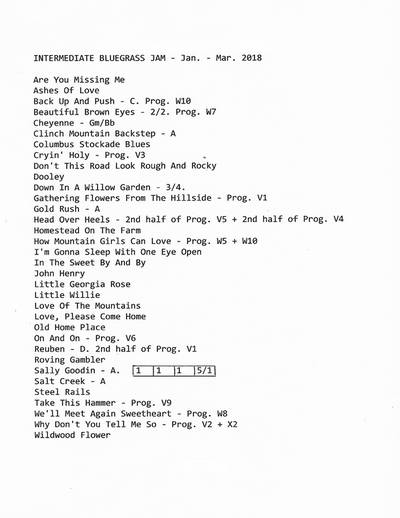
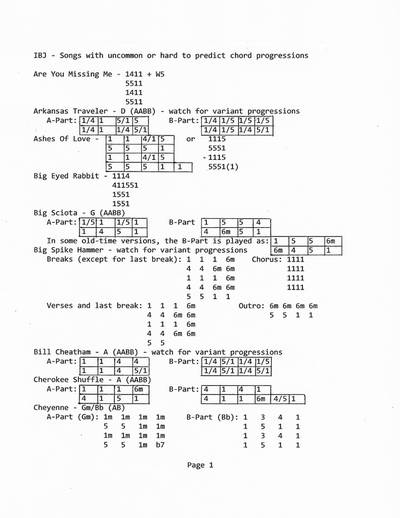
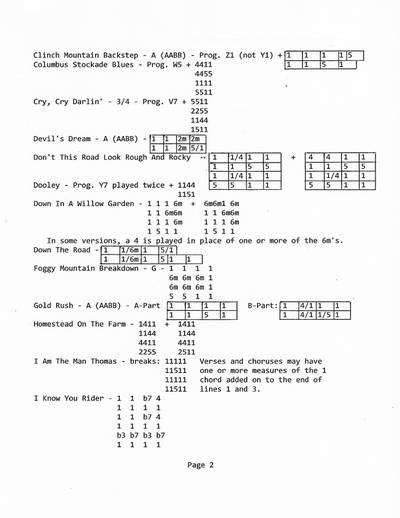
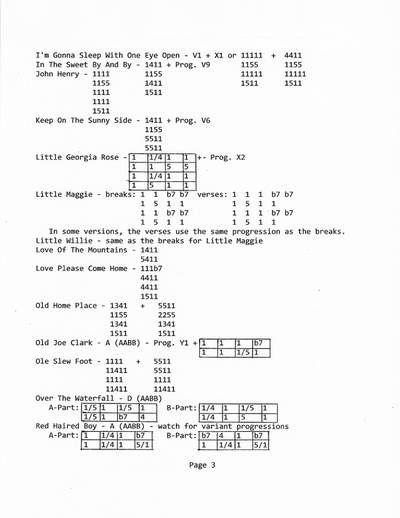
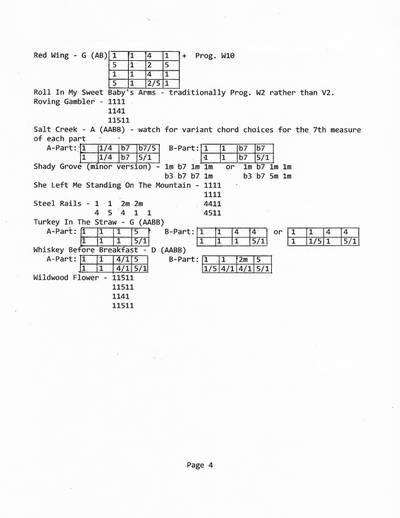

 RSS Feed
RSS Feed